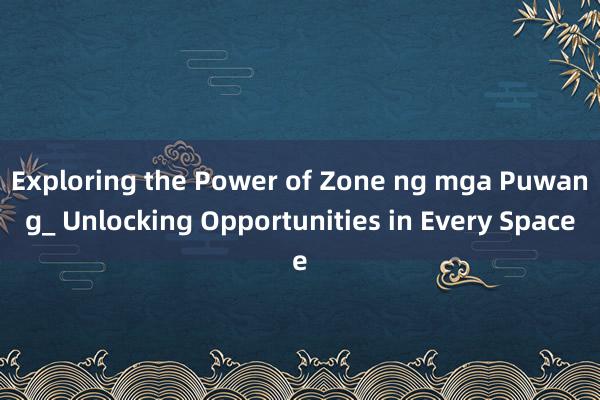Exploring the Power of Zone ng mga Puwang_ Unlocking Opportunities in Every Space


In the ever-evolving world of design, productivity, and space utilization, the concept of "zone ng mga puwang" (zones of spaces) has gained significant attention. This article dives into the innovative potential of this idea, how it can be applied to various domains, and the broader implications of maximizing every space around us.
Zone ng mga puwang, space optimization, productivity zones, creative spaces, modern design, interior design, space utilization, work-life balance, effective environments
Understanding the Concept of "Zone ng mga Puwang" (Zones of Spaces)
In our everyday lives, we often overlook the spaces we inhabit. Whether at home, work, or public areas, we tend to take for granted the power that the environment has on our productivity, well-being, and creativity. This is where the idea of "zone ng mga puwang," or zones of spaces, comes into play. It’s an innovative concept that encourages us to rethink how we use and interact with the spaces around us.
The Significance of Zones in Modern Living
To understand the essence of this concept, let’s first break down what “zones of spaces” refers to. In its simplest form, it suggests that every space has the potential to serve a specific purpose or function, and when designed thoughtfully, each zone can enhance the overall experience of the space.
For example, at home, we often have a living room, kitchen, bedroom, and other areas. But what if we took this a step further and created specific “zones” within these rooms? A corner for reading, a workspace for creativity, a dining nook for socializing — all within a single room. This is a growing trend in interior design, where zoning is applied not only for aesthetics but also for functionality and mental clarity.
In the context of workspaces, the concept of zoning is even more powerful. In an office setting, it’s common to find specific areas for collaboration, quiet work, brainstorming, and relaxation. By creating distinct zones for different activities, employees can mentally transition between tasks and environments, leading to increased focus and productivity.
Optimizing Space for Better Functionality
Space optimization is at the heart of the “zone ng mga puwang” concept. It is about making the most of what we have — whether it’s a small apartment, a large office, or an outdoor space. With modern design solutions, it is possible to turn any area into a multi-functional zone without sacrificing comfort or style.
For instance, a small studio apartment might be challenging to furnish, but by creating a designated sleep zone, work zone, and leisure zone, you can maximize the available space. Modern furniture such as foldable desks, convertible sofas, and multifunctional storage solutions allow us to create flexible zones that can easily be transformed as needed.
One of the biggest advantages of zoning spaces is the ability to control how a room feels. By separating spaces for different functions, go88 tài xỉu you can create a clear mental and emotional boundary. This separation helps to reduce distractions, phim rule 34 boost focus,chich69 and encourage productivity.
Zones in Nature: Bringing the Outdoors In
The concept of zones isn’t limited to interiors. It extends to outdoor spaces as well. Garden design, for example, often uses zoning to create areas for relaxation, entertainment, gardening, and dining. A well-designed outdoor space with clear zones can offer a sanctuary for individuals looking to unwind or connect with nature. Just as zoning applies to physical spaces inside, it’s equally effective in transforming your backyard into a beautiful, purposeful environment.
The Psychological Impact of Zones
The idea of creating zones isn’t just about aesthetics and functionality. There is a psychological aspect to it as well. Our minds are wired to respond to different environments in particular ways. When we enter a space that is designed to serve a specific function, we instinctively adapt to the mood and purpose of that zone.
For example, a workspace designed to encourage creativity will look very different from a zone intended for relaxation. Bright colors, energizing artwork, and collaborative tools might be present in the former, while soft lighting, calming tones, and comfortable seating define the latter. These design choices help influence how we think, feel, and behave within these spaces.
When we actively organize our environments into functional zones, we create an atmosphere that supports specific tasks, whether it's working, resting, or socializing. This intentional environment-setting can reduce stress and increase mental clarity, making it easier to focus on the task at hand.
Zoning and Productivity: How Workspaces Benefit from Defined Zones
A key area where the “zone ng mga puwang” concept has had a significant impact is in the workplace. In today’s fast-paced, multitasking world, the challenge is often not the tasks themselves but the environment in which they are completed. Open-plan offices, while designed for collaboration, can also lead to distractions and a lack of personal focus. This is where creating specific zones within the workplace is essential.
One zone might be designated for brainstorming sessions, complete with whiteboards, comfortable seating, and collaboration tools. Another zone could be for deep work, where quiet and privacy are prioritized, perhaps with noise-canceling headphones and desks spaced apart. A relaxation zone might have comfortable lounges or standing desks, allowing employees to take breaks or stretch during the day.
go88 tài xỉu vipHaving these distinct zones encourages employees to shift between different modes of thinking, from creative brainstorming to focused, individual work. By giving employees the freedom to choose a zone that suits their current task, organizations foster a more efficient and dynamic work culture.
The Importance of Boundaries: Separating Work and Home Life
In today’s world, with many people working remotely or in hybrid settings, creating clear boundaries between work and home life has become more critical than ever. A designated workspace within the home is an essential part of this. This is where zoning helps maintain balance by creating a specific area for professional activities and a separate zone for relaxation and family time.
When you establish physical boundaries between work and personal life, it helps mentally partition your day. After you finish working, leaving your “work zone” signals to your brain that it’s time to shift into personal mode. This separation reduces the risk of burnout and promotes a healthier work-life balance.
Practical Applications and Future Implications of "Zone ng mga Puwang"
As we dive deeper into the practical applications and future of “zone ng mga puwang,” we see that this concept is not just a passing trend. It is transforming the way we think about spaces, both public and private. Let’s explore how zoning can be applied in different contexts and how it’s shaping the future of design and productivity.
Zoning in the Digital Age: Virtual Spaces and Workflows
While the idea of physical zones is already well-established, we now live in an age where virtual spaces are just as important. With the rise of remote work, digital nomadism, and online collaboration, virtual zones have become an essential part of our daily lives. Zoning isn’t limited to physical spaces anymore — it extends to how we organize our digital environments as well.
For instance, many people now create “zones” on their computers or phones by organizing apps and files in a way that supports their workflow. Some might have separate digital spaces for work, personal projects, or social interactions, each with its own set of tools, software, and content. This digital zoning helps individuals stay focused and manage their time effectively.
Similarly, in collaborative online platforms, different “zones” might be created for teams working on specific projects, or for different functions such as brainstorming, problem-solving, and feedback. Creating these virtual boundaries helps streamline workflows and keeps tasks organized.
Zoning in Education: Creating Effective Learning Environments
Education, much like the workplace, can benefit from the concept of zoning. In the past, classrooms were designed with the traditional layout of desks in rows, all facing the teacher. However, modern educational environments are increasingly adopting flexible zoning principles to foster more interactive and collaborative learning experiences.
Today’s classrooms might feature different zones for various learning styles. For example, one area could be designed for quiet, independent study, while another might be set up for group discussions or hands-on activities. These distinct zones allow students to engage in diverse learning experiences, encouraging creativity, focus, and collaboration.
Zoning is also important in online education. Virtual classrooms often incorporate different zones for lectures, discussions, and assignments. By creating specific zones for different learning activities, online platforms can improve student engagement and outcomes.
Sustainable Design and Zoning: The Future of Eco-Friendly Spaces
As environmental concerns continue to grow, zoning also plays a crucial role in sustainable design. Zoning can help optimize the use of resources, reduce energy consumption, and minimize waste. For example, a building can be zoned to take advantage of natural light during the day, or different areas can be designated for recycling and composting. Urban planners are increasingly using zoning to create eco-friendly cities with green spaces, efficient transportation systems, and energy-saving buildings.
The Role of Zoning in Health and Wellness
One of the most profound implications of zoning is its impact on our health and wellness. As we understand more about how the built environment affects our physical and mental well-being, zoning becomes an essential tool in promoting health. Workplaces, homes, and public spaces are now being designed with wellness in mind, using zoning to create environments that support relaxation, exercise, and socialization.
For instance, incorporating green spaces into office buildings or urban areas can improve air quality, reduce stress, and increase overall satisfaction. By creating areas for physical activity, such as gyms or walking paths, we can encourage healthier lifestyles. At home, setting up a designated space for mindfulness or exercise can help individuals manage stress and improve mental health.
Conclusion: The Future of Spaces is Zoning
As we move forward, the concept of “zone ng mga puwang” will continue to shape how we interact with the world around us. Whether it’s optimizing physical spaces for functionality or creating virtual zones to enhance productivity, zoning has the power to transform our lives. By embracing this concept, we can unlock new opportunities in every space, from our homes to our workplaces and beyond.
As technology advances and our understanding of space and its impact on human behavior deepens, the potential for innovation in zoning is limitless. The future of spaces isn’t just about how much we have; it’s about how we use them to their fullest potential. With careful zoning, we can create environments that inspire creativity, productivity, and well-being for all.






